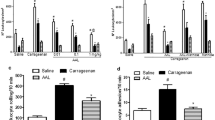Abstract
High (500 μg) and low 100μg) doses of carrageenin produced different temporal extravasation of plasma protein when injected into the rat paw. High doses caused a continuous extravasation parallel to the oedema increase. With low doses, main exudation occurred during the first 2 h and was minimal when the oedema was maximal (4th hour). Pre-treatment with indomethacin (2 mg/kg/i.p.) was effective in reducing oedema and protein extravasation for both doses of carrageenin. Indomethacin given 2 h after carrageenin had no effect upon the oedema caused by the low doses, but was effective with the high doses of carrageenin. The antioedematogenic effect of a non-steroid anti-inflammatory agent, such as indomethacin, was related to its effect upon plasma exudation, i.e. the agent was effective when there was a correlation between increment of oedema and plasma extravasation. The continuously increased plasma extravasation indicated the continuous presence of an active damaging stimulus. Our results explain several apparently contradictory observations reported in the literature.
Similar content being viewed by others
References
C.A. Winter, E.A. Risley andG.W. Nuss,Carrageenin-Induced Oedema in Hind Paw of the Rat as an Assay for Anti-Inflammatory Drugs, Proc. Soc. exp. Biol. Med,111, 544 (1962).
M. Di Rosa, J.P. Giroud andD.A. Willoughby,Studies of the Mediators of the Acute Inflammatory Response Induced in Rats of Different Sites by Carrageenin and Turpentine, J. Path.104, 15 (1971).
N.S. Doherty andB.V. Robinson The Inflammatory Response to Carrageenin, J. Pharm. Pharmac.27, 701 (1975).
J. Garcia Leme, L. Hamamura, M.P. Leite andM. Rocha e Silva,Pharmacological Analysis of the Acute Inflammatory Process Induced in the Rat's Paw by Local Injection of Carrageenin and by Heating, Br. J. Pharmac.48, 88 (1973a).
L. Levy,Report on R-760 in Carageenin Rat Paw Oedema Test. Biol. Sci. Tech. Rep., Riker Laboratories, Northridge, California (1971).
Sidney Siegel,Non Parametric Statistics for Behavioral Sciences. (McGraw-Hill Book Co, Inc., New York and Tokyo, 1956).
E.M. Landis,Capillary Pressure and Capillary Permeability, Physiol. Rev.14, 404 (1934).
J.D. Judah andD.A. Willoughby,Quantitiative Method for the Study of Capillary Permeability: Extraction and Determination of Trypan Blue in Tissues, J. Path. Bact.83, 567 (1962).
Benjamin W. Zweifach,Microvascular Aspects of Tissue Injury, in:The Inflammatory Process, vol. II. (Eds. Benjamin W. Zweifach, Lester Grant and Robert T. MacCluskey; Academic Press, New York and London, 1973), pp. 3–46.
R. Vinegar, W. Schreiber andR. H. Ugo,Biphasic Development of Carrageenan Edema in Rats, J. Pharmac. Exp. Ther.166, 96 (1969).
S.H. Ferreira andJ.R. Vane,New Aspects of the Mode of Action of Non-Steroid Anti-Inflammatory Drugs, Ann. Rev. Pharmacol,14, 57 (1974).
Author information
Authors and Affiliations
Rights and permissions
About this article
Cite this article
Zanin, M.T., Ferreira, S.H. Relationship between oedema and plasma exudation in rat paw carrageenin inflammation. Agents and Actions 8, 606–609 (1978). https://doi.org/10.1007/BF01998889
Received:
Issue Date:
DOI: https://doi.org/10.1007/BF01998889




